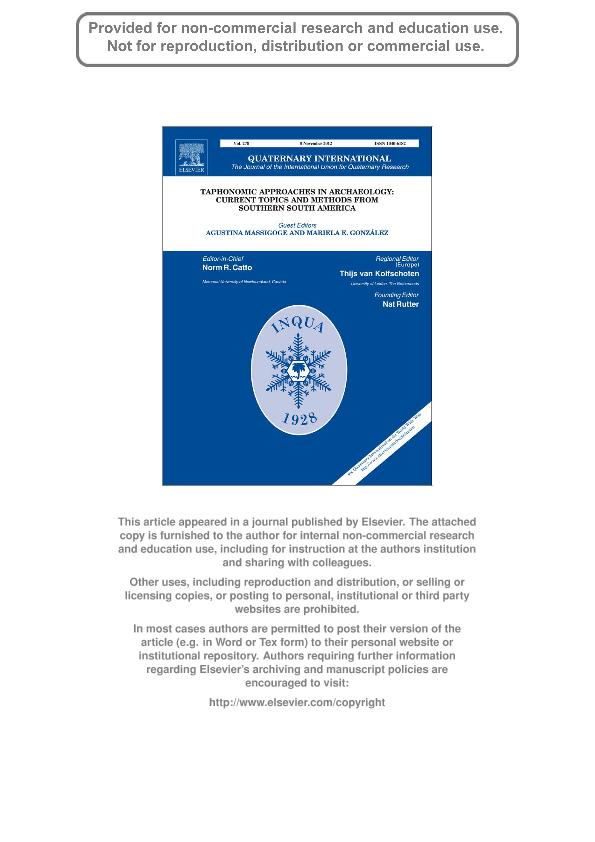Mostrar el registro sencillo del ítem
dc.contributor.author
Montalvo, Claudia Inés

dc.contributor.author
Cheme Arriaga, Lucas

dc.contributor.author
Tallade, Pedro O.
dc.contributor.author
Sosa, Ramón Alberto

dc.date.available
2018-08-31T21:14:57Z
dc.date.issued
2012-01
dc.identifier.citation
Montalvo, Claudia Inés; Cheme Arriaga, Lucas; Tallade, Pedro O.; Sosa, Ramón Alberto; Owl pellets dispersal by wind: observations and experimentations; Pergamon-Elsevier Science Ltd; Quaternary International; 278; 1-2012; 63-70
dc.identifier.issn
1040-6182
dc.identifier.uri
http://hdl.handle.net/11336/58013
dc.description.abstract
Pellets produced and accumulated by owls are subject to biological and atmospherical agents, and may be dispersed before their disaggregation. Observations on dispersion of Athene cunicularia and Tyto alba(Aves, Strigiformes) pellets were performed in a natural environment (Pampean region, Argentina) and in a wind tunnel. Ten burrows were visited, and the distances of pellets and isolated bones from the burrow entrance holes were registered. Intact pellets predominated between 0 and 1 m from the entrance holes. Partially disaggregated and disaggregated pellets showed similar distributions. In two burrows, the transport of new pellets and incorporated bones was observed during one month. Only in a few cases were the pellets mobilized and reoriented according to the predominant winds. Substratefeatures or the presence of vegetation favored fixing of their positions and prevented their mobility. Many of the pellets suffered total disaggregation or burial within the first 20 days to 1 month. Evaluated isolated bones showed a greater representation of mandibles and long bones, as well as skeletal elementswith low susceptibility to wind transport. Pellets evaluated in the wind tunnel, at low wind speed (2.70 m/s), were mobilized very short distances. At high wind speed (4.70 m/s), transport distance was greater. The distances travelled could be related to their initial orientation at the beginning of the experiments, as those that were placed at 90 to the wind flow showed greater transport. Theobservations showed that there were some differences in mobility between pellets of A. cunicularia and T. alba, as A. cunicularia were more susceptible to transport at each wind speed, likely attributed to their smaller size. Wind increased bone dispersion from partially disaggregated pellets, causing the loss of some of them.
dc.format
application/pdf
dc.language.iso
eng
dc.publisher
Pergamon-Elsevier Science Ltd

dc.rights
info:eu-repo/semantics/openAccess
dc.rights.uri
https://creativecommons.org/licenses/by-nc-sa/2.5/ar/
dc.subject
Pellets
dc.subject
Owl
dc.subject
Wind
dc.subject.classification
Arqueología

dc.subject.classification
Historia y Arqueología

dc.subject.classification
HUMANIDADES

dc.title
Owl pellets dispersal by wind: observations and experimentations
dc.type
info:eu-repo/semantics/article
dc.type
info:ar-repo/semantics/artículo
dc.type
info:eu-repo/semantics/publishedVersion
dc.date.updated
2018-07-23T17:22:16Z
dc.journal.volume
278
dc.journal.pagination
63-70
dc.journal.pais
Países Bajos

dc.journal.ciudad
Amsterdam
dc.description.fil
Fil: Montalvo, Claudia Inés. Universidad Nacional de La Pampa; Argentina
dc.description.fil
Fil: Cheme Arriaga, Lucas. Universidad Nacional de La Pampa; Argentina. Consejo Nacional de Investigaciones Científicas y Técnicas. Centro Científico Tecnológico Conicet - Centro Nacional Patagónico; Argentina
dc.description.fil
Fil: Tallade, Pedro O.. Universidad Nacional de La Pampa; Argentina
dc.description.fil
Fil: Sosa, Ramón Alberto. Universidad Nacional de La Pampa; Argentina
dc.journal.title
Quaternary International

dc.relation.alternativeid
info:eu-repo/semantics/altIdentifier/doi/http://dx.doi.org/10.1016/j.quaint.2012.01.027
dc.relation.alternativeid
info:eu-repo/semantics/altIdentifier/url/https://www.sciencedirect.com/science/article/pii/S1040618212000420
Archivos asociados
